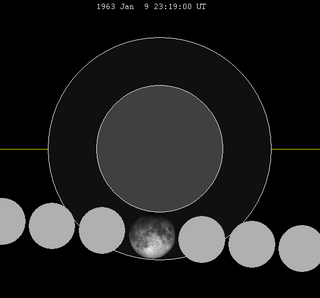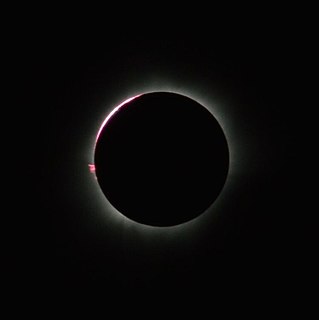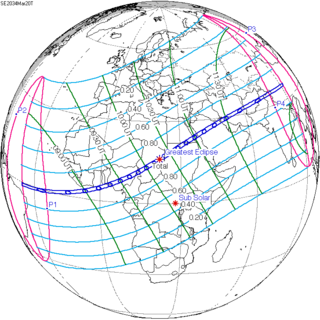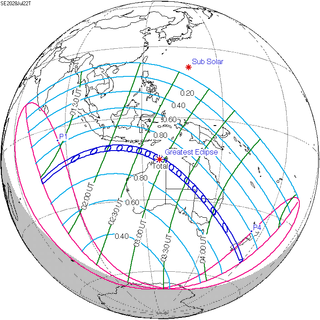
A lunar eclipse is an astronomical event that occurs when the Moon moves into the Earth's shadow, causing the Moon to be darkened. Such an alignment occurs during an eclipse season, approximately every six months, during the full moon phase, when the Moon's orbital plane is closest to the plane of the Earth's orbit.

An annular solar eclipse occurred at the Moon's descending node of the orbit on October 3, 2005, with a magnitude of 0.958. A solar eclipse occurs when the Moon passes between Earth and the Sun, thereby totally or partly obscuring the image of the Sun for a viewer on Earth. An annular solar eclipse occurs when the Moon's apparent diameter is smaller than the Sun's, blocking most of the Sun's light and causing the Sun to look like an annulus (ring). An annular eclipse appears as a partial eclipse over a region of the Earth thousands of kilometres wide. Occurring only 4.8 days after apogee, the Moon's apparent diameter was smaller. It was visible from a narrow corridor through the Iberian peninsula and Africa and Brazil. A partial eclipse was seen from the much broader path of the Moon's penumbra, including all of Europe, Africa and southwestern Asia. The Sun was 96% covered in a moderate annular eclipse, lasting 4 minutes and 32 seconds and covering a broad path up to 162 km wide. The next solar eclipse in Africa occurred just 6 months later.

A penumbral lunar eclipse took place on Sunday 30 December 2001, the last of three lunar eclipses in 2001. At maximum eclipse, 89.477% of the Moon's disc was partially shaded by the Earth, which caused a slight shadow gradient across its disc; this subtle effect may have been visible to careful observers. No part of the Moon was in complete shadow. The eclipse lasted 4 hours, 4 minutes and 17.7 seconds overall. This lunar eclipse followed the Annular Solar Eclipse on 14 December 2001.

A penumbral lunar eclipse took place on Sunday, January 31, 1999, the first of two lunar eclipses in 1999.
A penumbral lunar eclipse took place on 23 March 2016, the first of three lunar eclipses in 2016. The Moon was just 2.1 days before apogee, making it very small, so this was a "Micromoon" penumbral lunar eclipse.

A partial lunar eclipse took place on Monday, June 15, 1992, the first of two lunar eclipses in 1992, the second being with a total lunar eclipse on Wednesday, December 9.

A penumbral lunar eclipse took place on Wednesday, January 30, 1991, the first of four lunar eclipses in 1991.

A penumbral lunar eclipse occurred on Friday, 5 May 2023, the first of two lunar eclipses in 2023. The moon's apparent diameter was 0.1% larger than average because it occurred 5.5 days before perigee. This was the deepest penumbral eclipse since February 2017 and until September 2042.
A partial lunar eclipse took place on Tuesday, March 13, 1979, the first of two lunar eclipses in 1979. The Moon was strikingly shadowed in this deep partial eclipse which lasted 3 hours, 17 minutes and 40.6 seconds, with 85.377% of the Moon in darkness at maximum.

A partial lunar eclipse will take place on September 28, 2034. This will the second-shortest partial lunar eclipse for the 21st century lasting 26 minutes 42 seconds. On February 13, 2082, a slightly shorter partial eclipse will occur, lasting 25 minutes 30 seconds.

A penumbral lunar eclipse took place on Sunday, July 15, 1973, the third of four lunar eclipses in 1973, the first was a penumbral lunar eclipse on Thursday, January 18, the second was a penumbral lunar eclipse on Friday, June 15, and the last being with a partial lunar eclipse on Monday, December 10.

A penumbral lunar eclipse took place on Wednesday, January 9, 1963, the first of three lunar eclipses in 1963.

A total solar eclipse took place at the Moon's descending node of the orbit on March 8–9, 2016. If viewed from east of the International Date Line, the eclipse took place on March 8 (Tuesday) and elsewhere on March 9 (Wednesday). A total solar eclipse occurs when the Moon's apparent diameter is larger than the Sun's and the apparent path of the Sun and Moon intersect, blocking all direct sunlight and turning daylight into darkness; the Sun appears to be black with a halo around it. Totality occurs in a narrow path across Earth's surface, with the partial solar eclipse visible over a surrounding region thousands of kilometres wide. The eclipse of March 8–9, 2016 had a magnitude of 1.0450 visible across an area of Pacific Ocean, which started in the Indian Ocean, and ended in the northern Pacific Ocean.

A total solar eclipse will occur on Monday, March 20, 2034. A solar eclipse occurs when the Moon passes between Earth and the Sun, thereby totally or partly obscuring the image of the Sun for a viewer on Earth. A total solar eclipse occurs when the Moon's apparent diameter is larger than the Sun's, blocking all direct sunlight, turning day into darkness. Totality occurs in a narrow path across Earth's surface, with the partial solar eclipse visible over a surrounding region thousands of kilometres wide.

A hybrid solar eclipse occurred on Thursday, April 20, 2023. A solar eclipse occurs when the Moon passes between Earth and the Sun thereby totally or partly obscuring the Sun for a viewer on Earth. A hybrid solar eclipse is a rare type of solar eclipse that changes its appearance from annular to total and back as the Moon's shadow moves across the Earth's surface. Totality occurs in a narrow path across the surface of the Earth, with the partial solar eclipse visible over a surrounding region thousands of kilometers wide. Hybrid solar eclipses are extremely rare, occurring in only 3.1% of solar eclipses in the 21st century.

A total solar eclipse will occur on Saturday, July 22, 2028. The central line of the path of the eclipse will cross the Australian continent from the Kimberley region in the north west and continue in a south-easterly direction through Western Australia, the Northern Territory, south-west Queensland and New South Wales, close to the towns of Wyndham, Kununurra, Tennant Creek, Birdsville, Bourke and Dubbo, and continuing on through the centre of Sydney, where the eclipse will have a duration of over three minutes. It will also cross Queenstown and Dunedin, New Zealand. Totality will also be viewable from two of Australia's external territories: Christmas Island and Cocos (Keeling) Island.

An annular solar eclipse occurred on October 14, 2023. A solar eclipse occurs when the Moon passes between Earth and the Sun, thereby totally or partly obscuring the image of the Sun for a viewer on Earth. An annular solar eclipse occurs when the Moon's apparent diameter is smaller than the Sun's, blocking most of the Sun's light and causing the Sun to look like an annulus (ring). An annular eclipse appears as a partial eclipse over a region of the Earth thousands of kilometres or miles wide. Occurring only 4.6 days after apogee, the Moon's apparent diameter was small.

An annular solar eclipse will occur on Tuesday, September 12, 2034. A solar eclipse occurs when the Moon passes between Earth and the Sun, thereby totally or partly obscuring the image of the Sun for a viewer on Earth. An annular solar eclipse occurs when the Moon's apparent diameter is smaller than the Sun's, blocking most of the Sun's light and causing the Sun to look like an annulus (ring). An annular eclipse appears as a partial eclipse over a region of the Earth thousands of kilometres wide.

An annular solar eclipse will occur on Friday, October 25, 2041. A solar eclipse occurs when the Moon passes between Earth and the Sun, thereby totally or partly obscuring the image of the Sun for a viewer on Earth. An annular solar eclipse occurs when the Moon's apparent diameter is smaller than the Sun's, blocking most of the Sun's light and causing the Sun to look like an annulus (ring). An annular eclipse appears as a partial eclipse over a region of the Earth thousands of kilometres wide.

A supermoon is a full moon or a new moon that nearly coincides with perigee—the closest that the Moon comes to the Earth in its elliptic orbit—resulting in a slightly larger-than-usual apparent size of the Moon as viewed from Earth. The technical name is a perigee syzygy or a fullMoon around perigee. Because the term supermoon is astrological in origin, it has no precise astronomical definition.





































